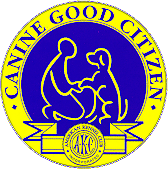|
 AKC's
Canine Good Citizen Test AKC's
Canine Good Citizen Test
The CGC Test
is to demonstrate that the dog as a companion of man, can be a respected member
of the community, and can be trained and conditioned to always behave in the home,
in public places, and in the presence of other dogs in a manner that will reflect
credit on the dog.
To qualify, a dog must pass each of the ten test categories listed below.
Please Note:
CGC is now an official AKC title and will now appear on a dog's registration certificate
or pedigree. It is meant to reward dogs for having good manners, which enhances
public acceptance of dogs. It is the first AKC program ever opened to non-purebred
dogs
NEW - HiDOC now offers a Canine Good Citizen Class. Check HERE for details.
| 1. |
Accepting a Friendly Stranger
- Demonstrate that the dog will allow a friendly stranger to approach and
speak to the handler in a natural, everyday situation. The dog must show no sign
of resentment or shyness, and must not break position or try to go to the Evaluator.
|
| 2. |
Sitting Politely for Petting
- Demonstrate that the dog will allow a friendly stranger to touch it while it
is out with its handler. |
| 3. |
Appearance and Grooming
- Demonstrate that the dog will welcome being groomed and examined and will permit
a stranger, to do so. It also demonstrates the owners care, concern and responsibility.
|
| 4. |
Out for a Walk (walking on loose
leash) - Demonstrate that the handler is in conntrol of the dog. The dog's
position should leave no doubt that the dog is attentive and is responding to
the handlers movements and changes of direction. The dog need not be in the "heel
position" and need not sit when the handler stops. |
| 5. |
Walking Through a Crowd
- Demonstrate that the dog can move about politely in pedestrian traffic and is
under control in public places. The dog and handler walk around and pass close
to several persons (at least 3). The dog may show some interest in the strangers,
without appearing over exuberant, shy or resentful. The dog should not be straining
at the leash. |
| 6. |
Sit and Down on Command/Staying
in Place - Demonstrate that the dog has training, will respond to the handlers
commands to sit and down and will remain in the place commanded by the handler
(sit or down position, whichever the handler prefers). The handler may not force
the dog into either position. The handler may use more than one command. |
| 7. |
Coming when Called - Demonstrate
that the dog will come when called by the handler. The handler may use body language
and encouragement to get the dog to come. Handlers may choose to tell dogs to
"stay" or "wait" or they may simply walk away, giving no instructions to the dog
as the evaluator provides mild distractions. |
| 8. |
Reaction to Another Dog -
Demonstrate that the dog can behave politely around other dogs. The dogs should
demonstrate no more than casual interest. Neither dog should go to the other dog
or handler. |
| 9. |
Reactions to Distractions
- Demonstrate that the dog is confident at all times when faced with common distracting
situations. The dog may express natural interest and curiosity, may startle but
should not panic, try to run away, show aggressiveness, or bark. |
| 10. |
Supervised Separation -
Demonstrate that the dog can be left alone, if necessary, and will maintain its
training and good manners. The dog should not continually bark, whine, howl or
pace unnecessarily or show anything other than mild agitation or nervousness. |
© 2002 High Desert Obedience Club. All rights reserved. |
|




